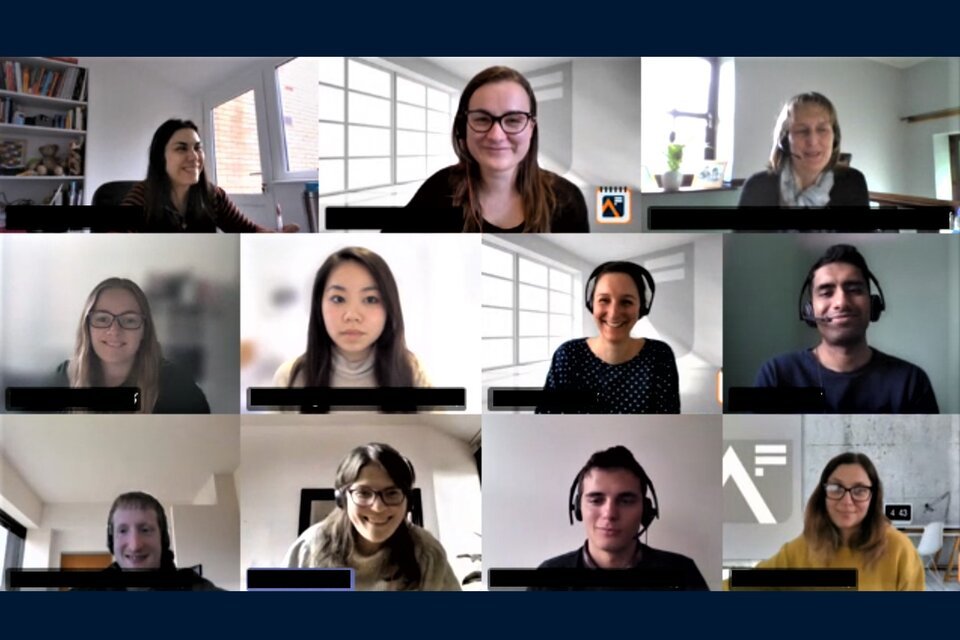Part four: Five things you didn't know about...
Our fourth selection of posts from across the Analysis Function, each sharing five facts about a topic or project

As part of Analysis in Government month, this is the fourth in our series of ‘Five things you didn’t know about…’ blog posts. Analysis in government is being used more than ever in policy, decision making and the media, this series of blog posts will share, showcase and celebrate the vast variety of professions and work within the Analysis Function.
Jump to one of our posts:
- Five things you didn’t know about the people shadowing the Analysis Function People Board
- Five things you didn’t know about Analysis Function fast streams
- Five things you didn’t know about the Government Operational Research Service (GORS) profession
- Five things you didn’t know about the role of buildings in net-zero and climate change
Five things you didn’t know about the people shadowing the Analysis Function People Board

Members of the Analysis Function People Board Shadow Board holding a virtual meeting
Written by Nicholas Webster, Welsh Government
The Analysis Function’s People Board (AFPB) Shadow Board (only in government would you get away with such a long name!) supports the work of the Analysis Function by shadowing a senior board specifically focusing on developing capability across government analysts.
The ultimate goal of the People Board is to ensure we have the right people in the right place with the right skills at the right time to deliver better analysis for better delivery. The role of the Shadow Board is here to bring new perspectives to board level discussions and ensure that decisions are representative of the thousands of analysts across government.
That was quite a technical explanation so below are five things you may not know about us:
1. We represent the people who make up the analysis function across government
We are 22 analysts from a range of professions and grades who come from all over government. From central Whitehall ministerial departments to Devolved Administrations to Government Agencies and Independent Regulators, we bring a wide range of experiences of analysis in government. We feed this experience into the Analysis Function’s People Board as the voice of analysts on the ground.
2. We have a seat at the table
We have representation at every board meeting and we are invited to comment on all papers circulated to the board. In the three months for which we have been up and running, we have also virtually met several members of the board. The senior People Board so far has been really supportive to our insight and really appreciate the wealth of experiences we bring. As the Shadow Board develops, we are also finding our feet as to what our priorities and are also starting to support engagement work of the analysis function so that colleagues can learn more about what the Analysis Function has to offer.
3. We are passionate about Diversity and Inclusion
Many of us already work within our departments on diversity and inclusion. However, this is a chance to contribute to strategies that aim to improve diversity and inclusion across government. We want to ensure that everyone’s potential is reached, regardless of their background, to ensure that the Analysis Function is as strong as it possibly can be, and everyone feels at home. We feel that while this is a complex task that needs to be addressed at all levels, the AFPB has a particularly important role in championing this work.
4. We do more than just analysis
Although we are all passionate about analysis in government, dare I say it, there’s more to life than government statistics, operational delivery and policy briefs. Some of the many hobbies taken up by members of the Shadow Board include, learning the keyboard, attempting to learn Arabic, sport, gardening and playing with 5 year old family members. There are also those of us have spent a lot of the past few months bingeing Netflix.
5. We would love to hear from the colleagues we represent
Although we do come from a range of backgrounds, every one of the (at last count) around 17,000 analysts in government has a different experience. This also doesn’t include the multitudes of colleagues we have who regularly do analysis but maybe don’t consider themselves to be government analysts. In our role as the Shadow Board, we would welcome thoughts on what more could and should be done to develop capability across government.
If you’d like to get in touch, please email analysis.function@ons.gov.uk
Five things you didn’t know about Analysis Function fast streams

Written by Fast Streamers (clockwise): Jack Ross, Shalisha Patrick, Rachel Knights, James Currell and Ollie Nixon
The Analysis Function is a cross-government network of around 17,000 people, it includes actuaries, economists, geographers, operational researchers, social researchers, statisticians and data scientists, analysts in the Digital, Data and Technology Profession and aspiring analysts. An opportunity to join the Analysis Function is through one of the five different Civil Service Fast Streams. Learn more about the Fast Streams below from five different analysts across government, talking about their work and experiences.
Opportunities with the Government Operational Research Service (GORS) Fast Stream
On the Operational Research Fast Stream, Jack Ross works in a team in the Department for Work and Pensions (DWP) with concerns from benefit customer vulnerability insight to forecasting the recovery of fraud and error related benefit debt.
I suppose there is a reason it’s called the ‘Fast Stream’! Only a few short months into my post here on the debt team and I’ve found myself being next up to lead the Recovery Model!
The Recovery Model is a large project, data is pulled/calculated by many SAS codes from the debt management system and used to make forecasts of how we’ll recover overpayments made on the various benefits the DWP recovers. The forecasts are relevant more-than-ever as ‘Fraud & Error’ is a large area of interest in the DWP especially with coronavirus (COVID-19) easements in effect!
My manager trusted me with this responsibility citing that as a Fast Streamer I should have the confidence and expertise to do this, but also that this is my opportunity to develop my technical and leading skills as I must be able to manage the workload and lead the development for the model. I don’t think I’d have this opportunity outside of the GORS Fast Stream!
2. Collaboration on the Digital, Data and Technology (DDaT) Fast Stream
In her first posting on the DDaT Fast Stream, Rachel Knights is currently a Live Service Analyst in Benefits and Credits, HM Revenue and Customs (HMRC). This team manages multiple legacy IT systems to ensure tax credits payments are made on time.
Joining the Fast Stream really has been a steep learning curve and I’ve been lucky to have been given a lot of responsibility early on. One project I’ve been leading on is user base analysis to determine the impacts of a system migration. Staring by identifying the thousands of users across HMRC using our system in various different roles, I then had to analyse the information they actually access in these roles. This work was vital to understanding what our users needed to facilitate their work and make sure this sense of User Needs was at the heart of any plans we made from migrations to a new system.
Being thrown into the deep end to lead on this analysis in a cross-government project and collaborate with colleagues in Department for Work and Pensions really helped me understand the importance of User Needs and analysis within all aspects of government working. In this case our users were not members of the public but instead fellow Civil Servants, the fundamental importance of analysing their needs and building our project around that remained the same. Ultimately it has been a great experience to understand how analysis facilitates the focus on user needs and how they are considered in attempts to remediate Legacy IT.
3. Responsibility on the Government Economic Service (GES) Fast Stream
James Currell is on the GES Fast Stream working in the Department for Health and Social Care (DHSC). The team he is a part of has a broad remit, his focus within the team is primarily on economic appraisal of NHS business cases.
Economics is a wide-reaching profession. As such economists are involved in a vast array of different work and the GES fast stream seems to have no shortage of opportunities and roles for its economists to get involved in.
My role centres around economic appraisal of business cases. I started my role in October 2020, since that time my responsibilities have increased tenfold. I am now responsible for reviewing and rating multiple cases at once, many with values upwards of hundreds of millions of pounds.
This is a tremendous responsibility and one I do not take lightly. I am empowered to carry out my work confidently thanks to a very supportive team, in particular my manager who has been brilliant in answering my questions about the role. The role has also offered me the chance to develop my leadership skills via supporting others wishing to get involved in economic appraisal.
4. Flexibility on the Government Social Research (GSR) Fast Stream
Shalisha is currently on the GSR Fast Stream, posted at the Department for Work and Pensions (DWP) in the Universal Credit Analysis Division.
I really enjoy my role as a Social Researcher. I undertake both in-house qualitative research and large-scale commissioned work to inform policy decisions related to Universal Credit. I will provide a couple of points on the things that I did not know before I joined the Fast Stream which I think would have been useful to know.
I have an Undergraduate Degree in Mathematics and a Masters in Social Policy. So, I have an interest in exploring both quantitative and qualitative data. When applying for the Fast Stream, I found it difficult to decide between the Statistics, Operational Research and Social Research fast streams. Since joining DWP, I’ve learnt that analytical roles are flexible. Analysts can move posts regularly, so we have the opportunity to choose a role which enables us to develop skills across the different analytical professions. Plus, you can be dual badged (e.g. be both a Social Researcher and Operational Researcher).
And secondly, I now know that DWP has the largest number of analysts out of all of the government departments. So, analysis and evidence is really valued and is used on most, if not all, projects. I’ve really enjoyed being able to work on a variety of interesting pieces of work that is truly appreciated and used to inform policy decisions.
5. Variety on the Government Statistical Service (GSS) Fast Stream
Ollie is currently in his third year on the GSS Fast Stream, posted to the Department for Work and Pensions (DWP) in the Universal Credit Official Statistics team.
At two and a half years through the Fast Stream and currently on my final posting for the programme, I can say that the process has been stretching and challenging, pushing me out of my comfort zone and helping me to develop a huge range of skills incredibly quickly.
Statistics is a broad profession in the Civil Service. I’ve enjoyed roles producing official statistics at Ofsted and the DWP, as well as a role supporting best practice across government while working at the Office for National Statistics (ONS). I even briefly worked on the COVID-19 press data slides to support the daily briefings! The reality is that every post has surprised me and offered me opportunities I never would have expected when I first started.
The most important thing about the GSS Fast Stream is that the opportunities I’ve enjoyed have not just been about my day-to-day statistics work. In my most recent posting, I was deployed to the Welsh Government to develop marine policy which is somewhat different to the work I had been used to. I also found myself involved in organising the GSS Conference, attended by over 1400 analysts from across government.
Throughout my time on the Fast Stream, I’ve really seen how the work that statisticians do – together with the other professions in the analysis function – sits at the heart of the Civil Service.
If any of the stories from analysts on the Fast Streams have inspired you to want to know more, further information is available on the Civil Service Fast Stream webpage.
Five things you didn’t know about the Government Operational Research Service (GORS) profession

Written by Vivienne Raven, HM Revenue and Customs
GORS is the cross-government profession of Operational Research (OR) analysts. There are currently over 1000 GORS analysts in over 25 central government departments and agencies.
1. History: Operational Research has its roots in Bletchley Park
The origins of OR in the military, particularly in World War II are well known. Some very clever people were put together to research operational problems and come up with solutions. Hence the name Operational Research.
However, less well known is that civil government OR formally began in 1968 with the publication of the Fulton Report and the establishment of the Civil Service department. A significant OR resource was deployed with the aim of establishing a network of OR groups throughout civil government. There was a vision for them to co-ordinate and co-operate supported by the OR Society.
2. Government OR in the 1970’s: computers made what we do easier, but we were doing analysis with pens and paper in the 70s
OR analysts in the 1970s worked on notable projects including:
- decimal coinage – modelling the flow of coins and estimating the number of decimal coins that needed to be minted
- selective checking of invoices – a value for money study on the cost of checking low value invoices
- a location of government study in 1973 which categorised work of the whole of civil government by assistant secretary (SCS1 level) and included a behavioural study on factors affecting staff moves
- development of a dynamic programming model to evaluate different government computing strategies
3. Government OR in 2020: We get better decisions made far wider than operations now
GORS analysts now work across all government departments using both traditional hard OR techniques such as simulation, optimisation, queueing theory, resource allocation and modelling, and softer problem structuring skills such as behavioural change and systems thinking. We produce evidence based analysis to support decision making.
As well as a strong presence in operational departments, we are also embedded in policy teams and those areas that are traditionally more economics and statistics focussed such as supporting the Budget, producing national statistics, modelling fraud and debt.
In 2020 OR and other analysts in HMRC were essential to the development of the Job Retention Scheme and the self employment grants.
Across the civil service GORS analysts worked on the epidemiological models feeding into SAGE to logistical support for vaccine distribution in DHSC, transport use in DfT, Universal Credit take-up in DWP.
4. Recruitment: we recruit analytical problem solvers
GORS recruit over 100 analysts from a wide range of backgrounds every year through
- student recruitment – industrial placements, summer projects
- mainstream recruitment – graduate recruitment of grades SO-SSO
- Fast Stream recruitment – GORS Fast Stream analysts
- GORS badging of civil servants working in analysis
And is one of the main recruiters of data scientists in the civil service.
We recruit great analytical problem solvers from a variety of backgrounds including astrophysics, mathematics, queueing theory and engineers. Many of our recruits have PhDs and Masters already, and our training programmes and apprenticeships ensure all of our people have access to new skills and techniques.
5. OR Society: We’re part of a large and growing community
The OR Society is the professional society for Operational Research. GORS members work alongside international academics and industry practitioners to promote OR and analytics particularly in education, training and on pro-bono projects.
Further information about OR can be found on the GORS website and the OR Society website.
Five things you didn’t know about the role of buildings in net-zero and climate change

Written by Chloe Whiting, Ministry of Housing, Communities and Local Government
In 2019 the UK government committed to reaching net-zero emissions by 2050. Economists across government provide vital modelling of different policy pathways to meet our climate targets and the projected emissions savings from policies. This is essential in order to measure progress towards net-zero and identify policy gaps which expose the government to risk of missing our legally binding targets.
1. Buildings are a major contributor of carbon, but challenges lay ahead when it comes to decarbonising the stock
In 2019 the buildings sector made up 19% (88 MtCO2e) of total UK greenhouse gas emissions by source category1. Our homes were responsible for 77% of the total emissions from buildings, with non-domestic and public sector buildings making up the rest. It’s therefore critical that we decarbonise our homes and offices if we are to achieve our climate targets.
However, there are significant economic challenges ahead for the sector: COVID-19 has led to the sharpest decline in GDP in modern history, with the construction industry shrinking by 12.5%; uncertainty arising from Brexit can negatively impact investment; and competing government priorities such as building safety and new housing supply mean there are difficult trade-offs to consider.
2. Government has an important role in this policy area
Improving the energy efficiency of buildings represents a significant opportunity to reduce carbon emissions. However, a number of market failures exist which mean government intervention is needed to fully capitalise on this:
- Negative externalities: energy prices do not fully reflect the climate change costs of burning fossil fuels.
- Imperfect information: consumers tend to have a lack of understanding of the benefits associated with improved energy performance, such as lower fuel bills, and how to improve it.
- Credit constraints: lower income households can be locked into energy inefficient homes with no means to upgrade them.
- Public goods: reduced carbon emissions from buildings leads to benefits including improved air quality which is a public good and therefore underprovided by the market.
3. We have clear levers to reduce the climate impact of new buildings
The building regulations are an important lever we have to improve energy efficiency of new buildings. Energy efficiency requirements are set by Part L of the Building Regulations: the conservation of fuel and power. Previous uplifts of the minimum standards set through Part L have led to substantial carbon savings over Carbon Budgets 1-5 through higher fabric standards.
However, tightening fabric standards further has diminishing returns. This means that in order to achieve the emissions reduction needed to meet the standards in the next proposed Part L uplifts in 2021 and 2025, new builds will have to include a form of low carbon heating like solar PV or an Air Source Heat Pump.
4. We have clear levers to reduce the climate impact of existing buildings
Given most buildings that will exist in 2050 have already been built, the scope to reduce the impact of buildings on climate change through new builds is limited. This means the majority of the existing stock will need to be retrofitted, costing an estimated £12 billion per annum up to 2050. There are various ways to target the existing stock:
- Part L: similarly to new buildings, Part L of the Building Regulations can be used to improve the energy efficiency of the existing stock. The new standards will be triggered when work is carried out on an existing building.
- Minimum energy efficiency standards: regulatory interventions like minimum energy performance (EPC) standards can be used to improve the energy efficiency of homes.
- Grants or subsidies: can incentivise homeowners to carry out energy efficiency improvements
5. There is more that can be done in the buildings sector to help address the remaining policy gap
In order to assess deliverability of the Carbon Budget 6 (CB6) target, which requires a 78% reduction in total UK greenhouse gas emissions by 2035 relative to 1990 levels, economists have modelled the estimated savings from all current and planned policies across government. This has shown there is an annual policy gap of 100 MtCO2e across all sectors over CB6, and so departments will need to develop new and ambitious policies to meet the target.
The buildings sector can play a unique role in helping to harness innovation and new technologies such as air source heat pumps and hydrogen, creating internal markets and building up supply chain capacity for these new technologies, and supporting green jobs as we ‘Build Back Better’.
We are hiring! This year is a really exciting year for climate change analysis with the opportunity to work on a wide portfolio of work – government is legislating for CB6, publishing the net-zero strategy, and hosting COP26. If you’re interested in joining our team please email Chloe.Whiting@communities.gov.uk or ramesh.deonarine@communities.gov.uk for more information, or just a chat about this fascinating subject.